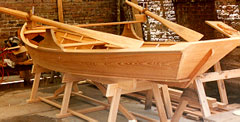Alex A. Giroir
Boatbuilding

Born in 1932 in the Assumption Parish community of Pierre Part, Alex Giroir grew up speaking Cajun French and English. An accomplished carpenter, he is skilled at making the wooden boats traditional to Atchafalaya Basin. He learned from his father, master boatbuilder Alexander Giroir. He says that he was "born into the boatbuilding tradition," and he "knew carpentry work before I knew anything else."
Using hand and power tools, Alex makes a variety of wooden boats, including pirogues and rowing skiffs. He sometimes works with his nephew, Raymond Sedatol.
Mr. Giroir's father once made traditional dugout pirogues from cypress logs. Around the turn of the century, the elder Mr. Giroir started building what they called "plank boats" or pirogues constructed of cypress planks because of the waste involved in making dugouts. Dugout pirogues used more than half a large cypress log, and a boatbuilder could make about 15 plank boats from the same wood, Alex Giroir explains.
Today, good cypress is hard to find and most wooden pirogues are now made of plywood--but even plywood planks are becoming hard to get Mr. Giroir says. Occasionally, he and Mr. Sedotal make aluminum pirogues, used for fishing and hunting in the swamps.
Mr. Giroir's wide-bottomed pirogues are exceptionally stable. He points out that he sets his seats differently than does Raymond Sedotal. Raymond sets his seats from one side of the boat to the other, but Mr. Giroir leaves an opening on each side of the seat. That way, if the boat tips, the seat won't get wet.
Alex Giroir does not make as many full-sized boats as he used to but makes miniature boats that he uses to describe boats rarely seen today and to talk about life in the swamps as it used to be. The barge, for instance, was used for collecting Spanish Moss, moss which was once used to stuff furniture, mattresses, and car seats.
The barge carried a platform on which a moss picker could stand, elevated about 20 feet from the bottom of the boat. Using a long hook, he could pick moss from the trees along the bayou. The barge would be filled with moss before the pickers returned home.
Moss pickers also used the Chaland, which carried two people. One man climbed trees to collect moss while the other stayed in the boat. They then rowed back to the larger barge to deposit heir moss. The Chaland was raked on both ends, so the men didn't have to turn the boat around to row back and forth to the barge.
Ferries were used to carry people across the bayou by means of a cable stretched across the water. Mr. Giroir built an old-fashioned ferry for use at Vermillionville in Lafayette.
He also makes cypress swings but finds it hard to get enough good wood to make many of them. The broad arms of his swings require "a good size piece of wood," he says.
As a master boatbuilder, Alex Giroir is a member of the Louisiana Crafts Program and has received many honors for his maintenance of this art. He has demonstrated boatbuilding at festivals through the United States and Louisiana, including the Smithsonians' Festival of American Folklife, the 1984 World's Fair in New Orleans, the Louisiana Folklife Festival, and the New Orleans Jazz and Heritage Festival. He is often accompanied by his wife Mazie Giroir, a fine traditional cook.


